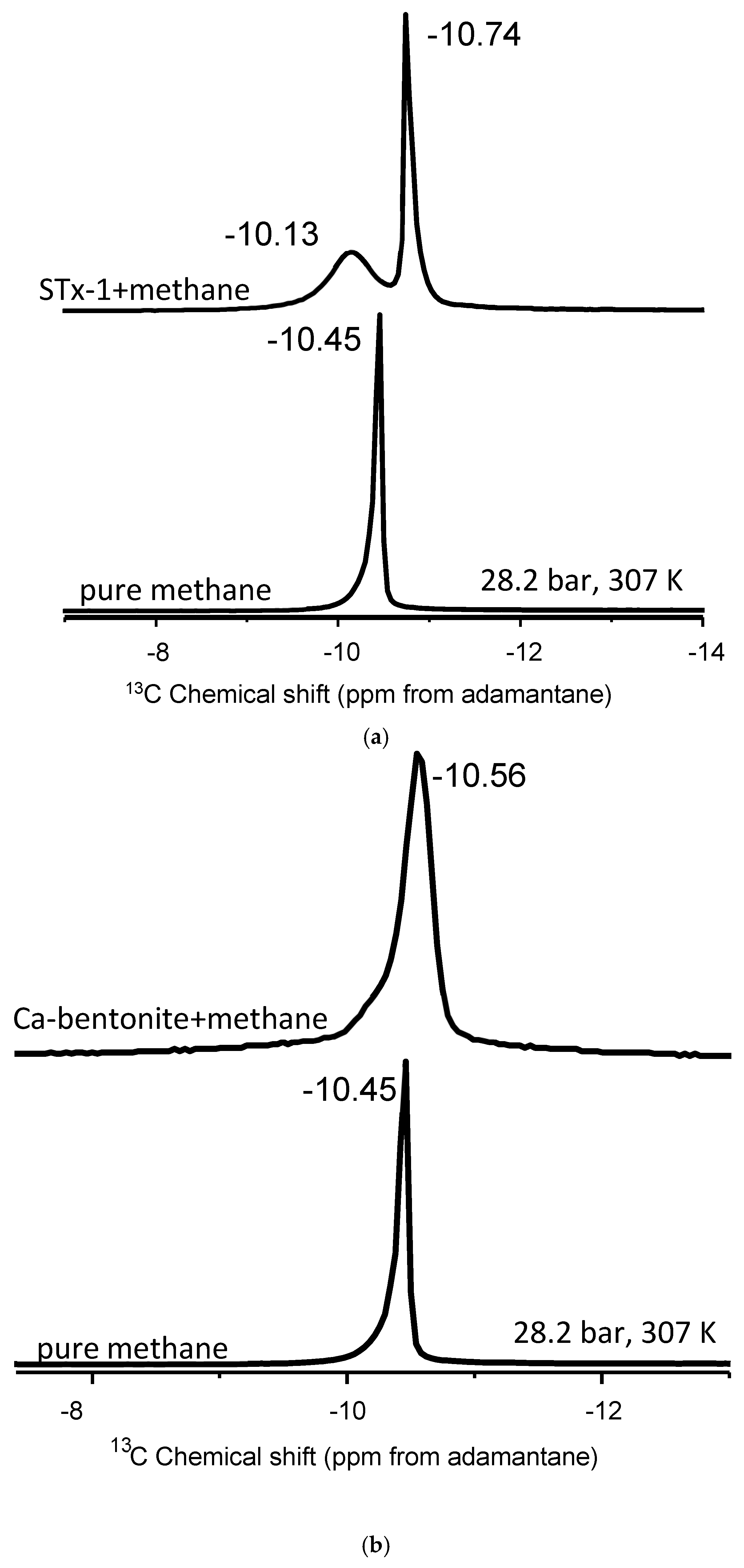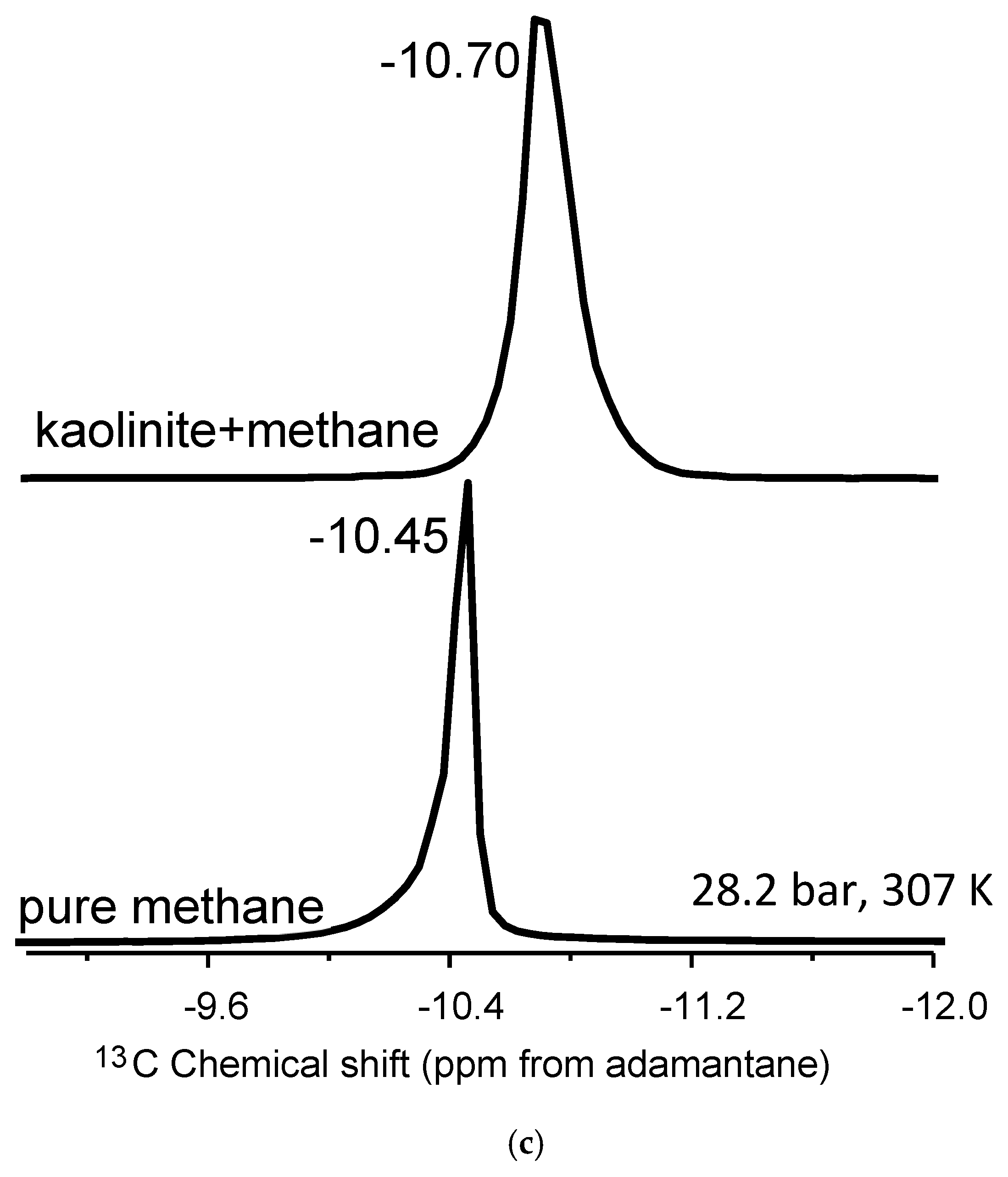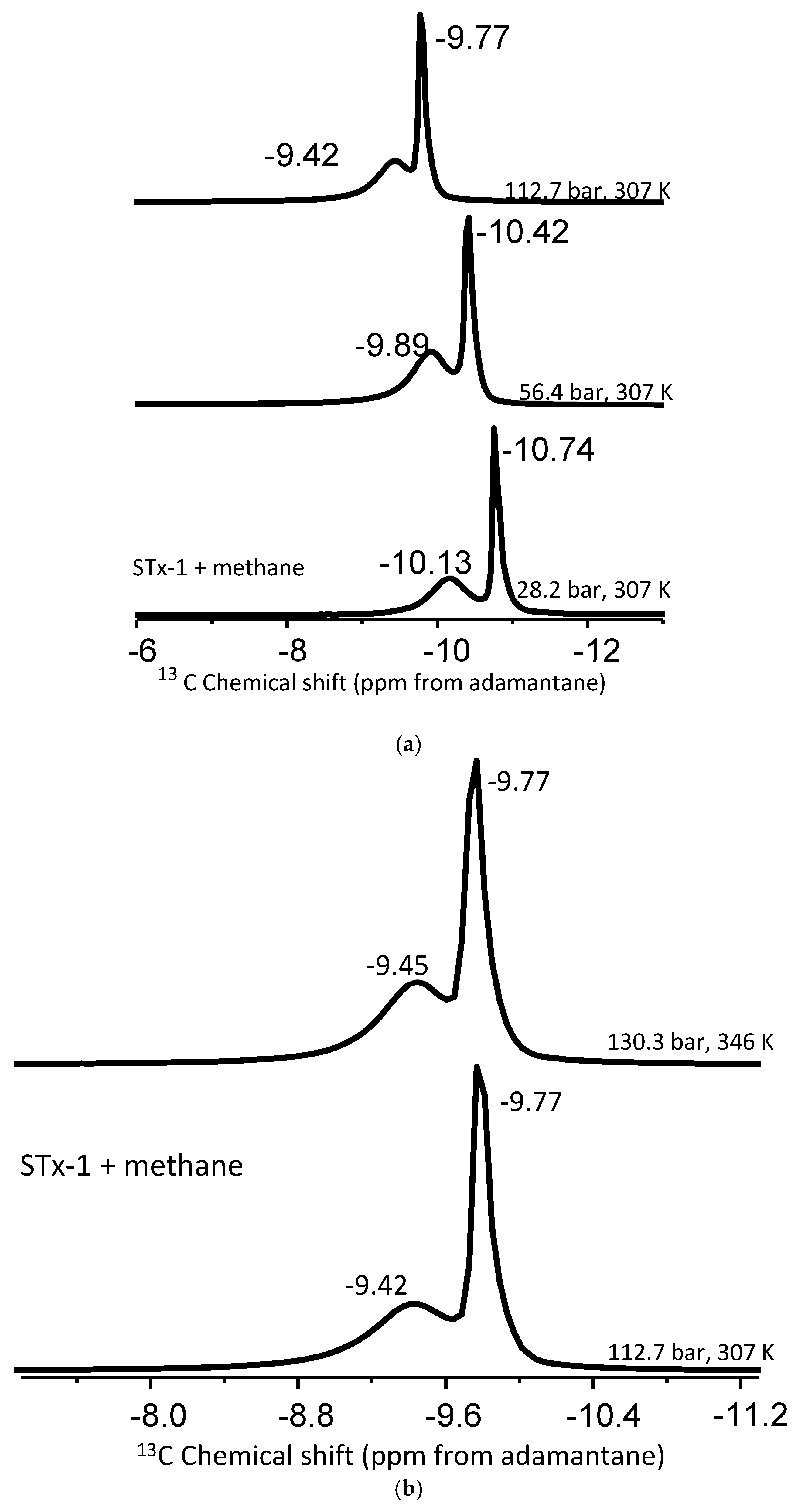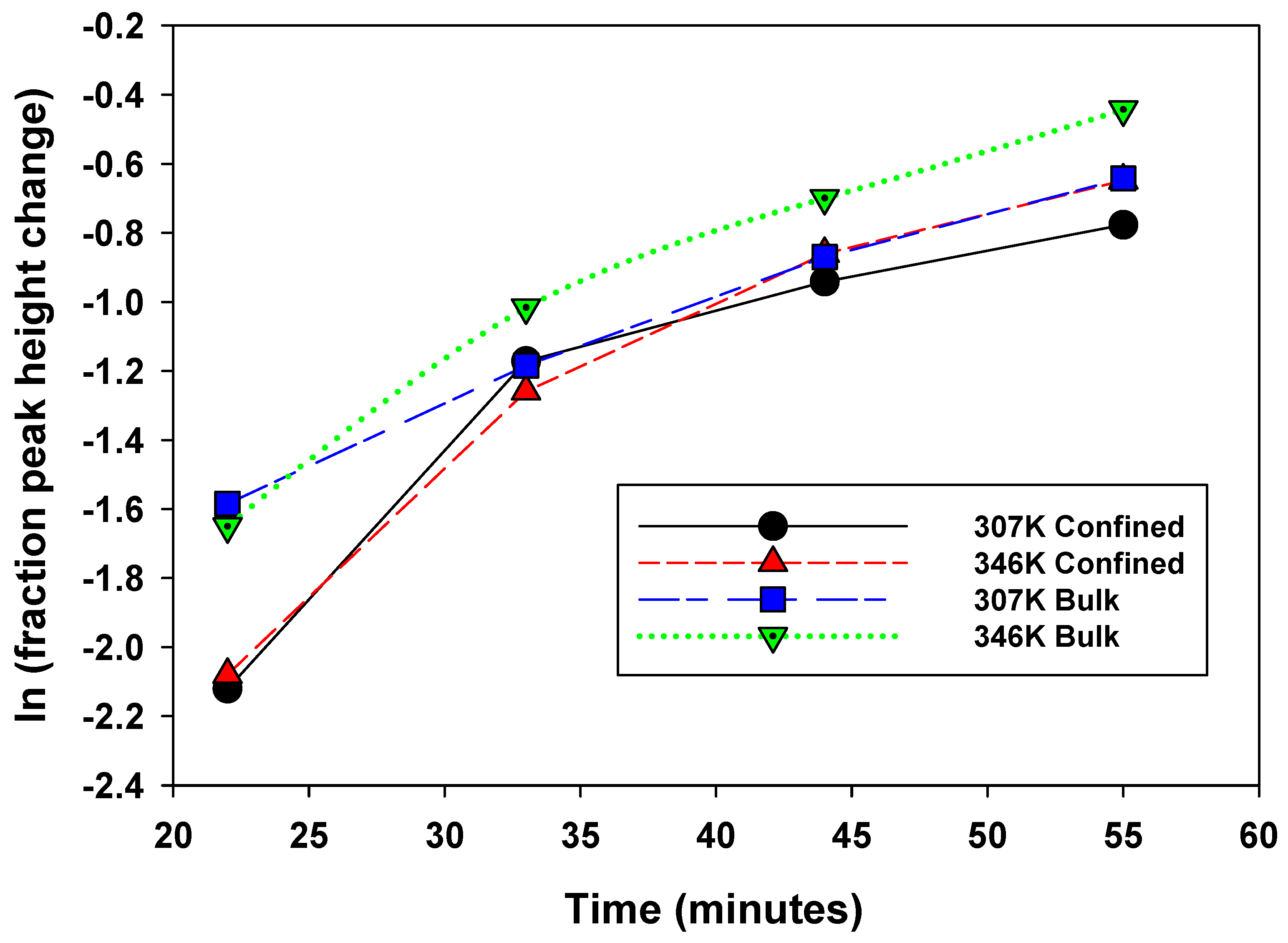Methane–Natural Clay Interfacial Interactions as Revealed by High-Pressure Magic Angle Spinning (MAS) Nuclear Magnetic Resonance (NMR) Spectroscopy
Abstract
:1. Introduction
Background and Objectives
2. Materials and Methods
2.1. Materials
2.2. Nuclear Magnetic Resonance: 13C Direct Polarization (DP) and 1H–13C Cross Polarization (CP)
3. Results and Discussion
3.1. Natural Clay Characterization
3.1.1. BET
3.1.2. SEM Measurements
3.2. High-Pressure MAS NMR
3.2.1. Methane Interaction with Kaolinite: Role of Surfaces
3.2.2. Methane Interaction with Ca-Saturated Montmorillonite (Ca-Bentonite) and Montmorillonite–Silica Assemblage
3.2.3. Effect of Pressure and Temperature
3.2.4. Comparison with Other Systems
3.2.5. Rates of Methane Release
- (a)
- Peak intensities decrease for both types of peaks at both temperatures with increasing time as pressure is released (Figure 5a,b).
- (b)
- At 22 min, there is a clear trend where the release rates of the bulk exceed those of the confined system: fractional change in peak heights of 0.2 versus 0.12, respectively,
- (c)
- Overall, the bulk fluid’s fastest release rate is observed at 346 K.
- (d)
- The slowest release rate is observed for confined peaks at 307 K.
- (e)
- The difference between release rates for bulk at 307 and confined at 346 is not easily distinguishable.
4. Conclusions
Author Contributions
Funding
Data Availability Statement
Acknowledgments
Conflicts of Interest
References
- Gelb, L.D.; Gubbins, K.E.; Radhakrishnan, R.; Sliwinska-Bartkowiak, M. Phase Separation in Confined Systems. Rep. Prog. Phys. 1999, 62, 1573–1659. [Google Scholar] [CrossRef]
- Cole, D.R.; Striolo, A. The Influence of Nanoporosity on the Behavior of Carbon-bearing Fluids. In Deep Carbon: Past and Present; Cambridge University Press: Cambridge, UK, 2019; pp. 358–387. [Google Scholar]
- Cole, D.R.; Ok, S.; Striolo, A.; Phan, A. Hydrocarbon Behavior at Nanoscale Interfaces. Rev. Mineral. Geochem. 2013, 75, 495–545. [Google Scholar] [CrossRef]
- Cole, D.R.; Arthur, M.A. Unconventional Hydrocarbons. Elements 2014, 10, 257–296. [Google Scholar]
- Striolo, A.; Cole, D.R. Understanding Shale Gas: Recent Progress and Remaining Challenges. Energy Fuels 2017, 31, 10300–10310. [Google Scholar] [CrossRef]
- Ambrose, R.J.; Hartman, R.C.; Campos, M.D.; Akkutlu, I.Y.; Sondergeld, K. New Pore-scale Considerations for Shale Gas in Place Calculations. In Proceedings of the SPE Unconventional Gas Conference, Pittsburgh, PA, USA, 23–25 February 2010; 131772-MS. Society of Petroleum Engineers: Calgary, AB, Canada, 2010. [Google Scholar]
- Ruhle, B.; Davies, M.; Lebold, T.; Brauchle, C.; Bein, T. Highly Oriented Mesoporous Silica Channels Synthesized in Microgrooves and Visualized with Single-molecule Diffusion. ACS Nano 2012, 6, 1948–1960. [Google Scholar] [CrossRef]
- Yethiraj, A.; Striolo, A. Fracking: What Can Physical Chemistry Offer? J. Phys. Chem. Lett. 2013, 4, 687–690. [Google Scholar] [CrossRef]
- Wang, H.-J.; Mutina, A.; Kausik, R. High-Field Nuclear Magnetic Resonance Observation of Gas Shale Fracturing by Methane Gas. Energy Fuels 2014, 28, 3638–3644. [Google Scholar] [CrossRef]
- Hoyt, D.W.; Turcu, V.F.; Sears, J.A.; Rosso, K.M.; Burton, S.D.; Felmy, A.R.; Hu, J.Z. High-pressure Magic Angle Spinning Nuclear Magnetic Resonance. J. Magn. Reson. 2011, 212, 378–385. [Google Scholar] [CrossRef]
- Turcu, R.V.F.; Hoyt, D.W.; Rosso, K.M.; Sears, J.A.; Loring, J.S.; Felmy, A.R.; Hu, J.Z. Rotor Design for High-Pressure Magic Angle Spinning Nuclear Magnetic Resonance. J. Magn. Reson. 2013, 226, 64–69. [Google Scholar] [CrossRef]
- Chen, P.-H.; Gao, C.; Price, L.E.; Urban, M.A.; Popp, T.M.O.; Barnes, A.B. Two Millimeter Diameter Spherical Rotors Spinning at 68 kHz for MAS NMR. J. Magn. Res. 2021, 8–9, 100015. [Google Scholar] [CrossRef]
- Miyoshi, T.; Takegoshi, K.; Terao, T. A Simple Method for 13C CPMAS NMR Measurements under High Gas Pressures. J. Magn. Reson. 1997, 125, 383–384. [Google Scholar] [CrossRef]
- Deuchande, T.; Breton, O.; Haedelt, J.; Hughes, E. Design and Performance of a High Pressure Insert for Use in a Standard Magic Angle Spinning NMR Probe. J. Magn. Reson. 2006, 183, 178–182. [Google Scholar] [CrossRef] [PubMed]
- Bowers, G.M.; Schaef, H.T.; Loring, J.S.; Hoyt, D.W.; Burton, S.D.; Walter, E.D.; Kirkpatrick, R.J. Role of Cations in CO2 Adsorption, Dynamics, and Hydration in Smectite Clays under In Situ Supercritical CO2 Conditions. J. Phys. Chem. C 2017, 121, 577–592. [Google Scholar] [CrossRef]
- Bowers, G.M.; Schaef, H.T.; Miller, Q.R.S.; Walter, E.D.; Burton, S.D.; Hoyt, D.W.; Horner, J.A.; Loring, J.S.; McGrail, B.P.; Kirkpatrick, R.J. 13C Nuclear Magnetic Resonance Spectroscopy of Methane and Carbon Dioxide in a Natural Shale. ACS Earth Space Chem. 2019, 3, 324–328. [Google Scholar] [CrossRef]
- Bowers, G.M.; Loring, J.S.; Schaef, H.T.; Cunniff, S.S.; Walter, E.D.; Burton, S.D.; Larsen, R.K.; Miller, Q.R.; Bowden, M.E.; Ilton, E.S.; et al. Chemical Trapping of CO2 by Clay Minerals at Reservoir Conditions: Two Mechanisms Observed by in Situ High-Pressure and -Temperature Experiments. ACS Earth Space Chem. 2019, 3, 1034–1046. [Google Scholar] [CrossRef]
- Loganathan, N.; Bowers, G.M.; Yazaydin, A.O.; Schaef, H.T.; Loring, J.S.; Kalinichev, A.G.; Kirkpatrick, R.J. Clay Swelling in Dry Supercritical Carbon Dioxide: Effects of Interlayer Cations on the Structure, Dynamics, and Energetics of CO2 Intercalation Probed by XRD, NMR, and GCMD Simulations. J. Phys. Chem. C 2018, 122, 4391–4402. [Google Scholar] [CrossRef]
- Bowers, G.M.; Loring, J.S.; Schaef, H.T.; Walter, E.D.; Burton, S.D.; Hoyt, D.W.; Cunnif, S.S.; Loganathan, N.; Kirkpatrick, R.J. Interaction of Hydrocarbons with Clays at Reservoir Conditions: In situ IR and NMR Spectroscopy and X-ray Diffraction for Expandable Clays with Variably Wet Supercritical Methane. ACS Earth Space Chem. 2018, 2, 640–652. [Google Scholar] [CrossRef]
- Loring, J.S.; Schaef, H.T.; Turcu, R.V.F.; Thompson, C.J.; Miller, Q.R.S.; Martin, P.F.; Hu, J.; Hoyt, D.W.; Qafoku, O.; Ilton, E.S.; et al. In Situ Molecular Spectroscopic Evidence for CO2 Intercalation into Montmorillonite in Supercritical Carbon Dioxide. Langmuir 2012, 28, 7125–7128. [Google Scholar] [CrossRef]
- Schaef, H.T.; Loring, J.S.; Glezakou, V.-A.; Miller, Q.R.S.; Chen, J.; Owen, A.T.; Lee, M.-S.; Ilton, E.S.; Felmy, A.R.; McGrail, B.P.; et al. Competetive Sorption of CO2 and H2O in 2:1 Layer Phyllosilicates. Geochim. Cosmochim. Acta 2015, 161, 248–257. [Google Scholar] [CrossRef]
- Geist, M.F.; Boussois, K.; Smith, A.; Peyratout, C.S.; Kurth, D.G. Nanocomposites Derived from Montmorillonite and Metallosupramolecular Polyelectrolytes: Modular Compounds for Electrorheological Fluids. Langmuir 2013, 29, 1743–1747. [Google Scholar] [CrossRef]
- Zhu, R.; Chen, Q.; Liu, H.; Ge, F.; Zhu, L.; Zhu, J.; He, H. Montmorillonite as a Multifunctional Adsorbent can Simultaneously Remove Crystal Violet, Cetyltrimethylammonium, and 2-naphtol from Water. Appl. Clay Sci. 2014, 88–89, 33–38. [Google Scholar] [CrossRef]
- Bertuoli, P.T.; Piazza, D.; Scienza, L.C.; Zattera, A.J. Preparation and Characterization of Montmorillonite Modified with 3-aminopropylethoxysilane. Appl. Clay Sci. 2014, 87, 46–51. [Google Scholar] [CrossRef]
- Ji, L.; Zhang, T.; Milliken, K.L.; Qu, J.; Zhang, X. Experimental Investigation of Main Controls to Methane Adsorption in Clay-rich Rocks. Appl. Geochem. 2012, 27, 2533–2545. [Google Scholar] [CrossRef]
- Yeon, S.-H.; Seol, J.; Seo, Y.; Park, Y.; Koh, D.-Y.; Park, K.-P.; Huh, D.-G.; Lee, J.; Lee, H. Effect of Interlayer Ions on Methane Hydrate Formation in Clay Sediments. JPCB Lett. 2009, 113, 1245–1248. [Google Scholar] [CrossRef] [PubMed]
- Sanders, R.L.; Washton, N.M.; Mueller, K.T. Measurement of the Reactive Surface Area of Clay Minerals Using Solid-state NMR Studies of a Probe Molecule. J. Phys. Chem. C 2010, 114, 5491–5498. [Google Scholar] [CrossRef]
- Cheng, A.L.; Huang, W.-L. Selective Adsorption of Hydrocarbon Gases on Clays and Organic Matter. Org. Geochem. 2004, 35, 413–423. [Google Scholar] [CrossRef]
- Michalopoulos, P.; Aller, R.C. Rapid Clay Mineral Formation in Amazon Delta Sediments: Reverse Weathering and Oceanic Elemental Cycles. Science 1995, 270, 614–617. [Google Scholar] [CrossRef]
- Breen, C.; Moronta, A. Influence of Layer Charge on the Catalytic Activity of Mildly Acid-activated Tetramethylammonium-exchanged Bentonites. J. Phys. Chem. B 1999, 103, 5675–5680. [Google Scholar] [CrossRef]
- Castellini, E.; Malferrari, D.; Bernini, F.; Brigatti, M.F.; Castro, G.R.; Medici, L.; Mucci, A.; Borsari, M. Baseline Studies of the Clay Minerals Society Source Clay Montmorillonite STx-1b. Clays Clay Miner. 2017, 65, 220–233. [Google Scholar] [CrossRef]
- Chipera, S.J.; Bish, D.L. Baseline Studies of the Clay Minerals Society Source Clays: Powder X-Ray Diffraction Analyses. Clays Clay Miner. 2001, 49, 398–409. [Google Scholar] [CrossRef]
- Fatt, I. The Network Model of Porous Media. Trans. AIME 1956, 207, 144–181. [Google Scholar] [CrossRef]
- Kewen, W.; Ning, L. Numerical Simulation of Rock Pore-throat Structure Effects on NMR T2 Distribution. Appl. Geophys. 2008, 5, 86–91. [Google Scholar] [CrossRef]
- Leong, Y.-K.; Liu, P.; Au, P.-I.; Clode, P.; Liu, J. Microstructure and Time-dependent Behavior of STx-1b Calcium Montmorillonite Suspensions. Clays Clay Miner. 2021, 69, 787–796. [Google Scholar] [CrossRef]
- Thao, H.-M. Characterization of Clays and Clay Minerals for Industrial Applications: Substitution Non-Natural Additives by Clays in UV Protection. Ph.D. Thesis, Ernst-Moritz-Arndt-University Greifswald, Greifswald, Germany, 2006. [Google Scholar]
- Bhattacharyya, K.G.; SenGupta, S.; Sarma, G.K. Interactions of the Dye, Rhodamine B with Kaolinite and Montmorillonite in Water. Appl. Clay Sci. 2014, 99, 7–17. [Google Scholar] [CrossRef]
- Ilton, E.S.; Schaef, H.T.; Qafoku, O.; Rosso, K.M.; Felmy, A.R. In situ X-ray Diffraction Study of Na+ Saturated Montmorillonite Exposed to Variably Wet Supercritical CO2. Environ. Sci. Technol. 2012, 46, 4241–4248. [Google Scholar] [CrossRef]
- Schaef, H.T.; Ilton, E.S.; Qafoku, O.; Martin, P.F.; Felmy, A.R.; Rosso, K.M. In situ XRD Study of Ca2+ Saturated Montmorillonite (STX-1) Exposed to Anhydrous and Wet Supercritical Carbon Dioxide. Int. J. Greenh. Gas Control 2012, 6, 220–229. [Google Scholar] [CrossRef]
- Bielecki, A.; Burum, D.P. Temperature Dependence of 207Pb MAS Spectra of Solid Lead Nitrate. An Accurate, Sensitive Thermometer for Variable-Temperature MAS. J. Magn. Reson. Ser. A 1995, 116, 215–220. [Google Scholar] [CrossRef]
- Langer, B.; Schnell, I.; Spiess, H.W.; Grimmer, A.-R. Temperature Calibration under Ultrafast MAS Conditions. J. Magn. Reson. 1999, 138, 182–186. [Google Scholar] [CrossRef]
- Ok, S.; Hoyt, D.W.; Andersen, A.; Sheets, J.; Welch, S.; Cole, D.R.; Mueller, K.; Washton, N.M. Surface Interactions and Confinement of Methane: A High Pressure Magic Angle Spinning NMR and Computational Chemistry Study. Langmuir 2017, 33, 1359–1367. [Google Scholar] [CrossRef]
- Thermophysical Properties of Fluid Systems. Available online: http://webbook.nist.gov/chemistry/fluid/ (accessed on 13 February 2025).
- Widjaja, B.; Inkiriwang, C.B. Empirical Correlations among Liquid Limit, Clay Fraction, and Specific Surface Area for Kaolin and Calcium Bentonite Compounded Samples. In Proceedings of the Fifth International Conference on Advances in Civil and Structural Engineering—CSE 13 March 2016, Kuala Lumpur, Malaysia, 12–13 March 2016; pp. 42–44. [Google Scholar]
- Koskela, T.; Ylihautala, M.; Vaara, J.; Jokisaari, J. 13C NMR Spectroscopy of Methane Adsorbed in SAPO-11 Molecular Sieve. Chem. Phys. Lett. 1996, 261, 425–430. [Google Scholar] [CrossRef]
- Koskela, T.; Ylihautala, M.; Jokisaari, J.; Vaara, J. C-13 NMR of Methane in an AlPO4-11 Molecular Sieve: Exchange Effects and Shielding Anisotropy. Phys. Rev. B 1998, 58, 14833–14836. [Google Scholar] [CrossRef]
- Fleyfel, F.; Song, K.Y.; Kook, A.; Martin, R.; Kobayashi, R. Interpretation of C-13 NMR of Methane Propane Hydrates in the Metastable Nonequilibrium Region. J. Phys. Chem. 1993, 97, 6722–6725. [Google Scholar] [CrossRef]
- Loring, J.S.; Ilton, E.S.; Chen, J.; Thompson, C.J.; Martin, P.F.; Benezeth, P.; Rosso, K.M.; Felmy, A.R.; Schaef, H.T. In Situ Study of CO2 and H2O Partitioning between Na-Montmorillonite and Variably Wet Supercritical Carbon Dioxide. Langmuir 2014, 30, 6120–6128. [Google Scholar] [CrossRef] [PubMed]
- Ok, S.; Gautam, S.; Liu, K.-H.; Cole, D.R. Surface Interactions and Nanoconfinement of Methane and Methane plus CO2 Revealed by High-Pressure Magic Angle Spinning NMR Spectroscopy and Molecular Dynamics. Membranes 2022, 12, 1273. [Google Scholar] [CrossRef] [PubMed]
- Bish, D. (Department of Chemistry at Indiana University Bloomington, Bloomington, IN, USA). Personal communication, 2024.
- Wu, S.; Luo, W.; Fang, S.; Sun, Z.; Yan, S.; Li, Y. Wettability Impact on Nanoconfined Methane Adsorption Behavior: A Simplified Local Density Investigation. Energy Fuels 2022, 36, 14204–14219. [Google Scholar] [CrossRef]
- Jameson, A.K.; Jameson, C.J. Gas-Phase 13C Chemical Shifts in the Zero-Pressure Limit: Refinements to the Absolute Shielding Scale for 13C. Chem. Phys. Lett. 1987, 134, 461–466. [Google Scholar] [CrossRef]
- Ok, S. Low-field NMR Investigations on Dynamics of Crude Oil Confined into Nanoporous Silica Rods and White Powder. Front. Chem. 2023, 11, 1087474. [Google Scholar] [CrossRef]
- Wu, J.; Li, S.; Li, G.; Li, C.; Xin, Q. FT-IR Investigation of Methane Adsorption on Silica. Appl. Surf. Sci. 1994, 81, 37–41. [Google Scholar] [CrossRef]
- Terenzi, C.; Dvinskikh, S.V.; Furo, I. Wood Microstructure Explored by Anisotropic H-1 NMR Line Broadening: Experiments and Numerical Simulations. J. Phys. Chem. B 2013, 117, 8620–8632. [Google Scholar] [CrossRef]
- Bonardet, J.L.; Fraissard, J.P. Method of Correcting Chemical Shifts of Adsorbate Molecules for Adsorbent Susceptibility. J. Magn. Reson. 1976, 22, 543–548. [Google Scholar] [CrossRef]
- Schurr, J.M. Phenomena Associated with Gel-Water Interfaces. Analyses and Alternatives to the Long-Range Ordered Water Hypothesis. J. Phys. Chem. B 2013, 117, 7653–7674. [Google Scholar] [CrossRef] [PubMed]
- Perret, E.; Nygard, K.; Satapathy, D.K.; Balmer, T.E.; Bunk, O.; Heuberger, M.; van der Veen, J.F. Molecular Liquid under Nanometre Confinement: Density Profiles Underlying Oscillatory Forces. J. Phys.-Cond. Matt. 2010, 22, 235102. [Google Scholar] [CrossRef] [PubMed]
- Zhang, Y.; Faraone, A.; Kamitakahara, W.A.; Liu, K.H.; Mour, C.Y.; Leao, J.B.; Chang, S.; Chen, S.H. Density Hysteresis of Heavy Water Confined in a Nanoporous Silica Matrix. Proc. Natl. Acad. Sci. USA 2011, 108, 12206–12211. [Google Scholar] [CrossRef] [PubMed]
- Heuberger, M.; Zach, M.; Spencer, N.D. Density Fluctuations under Confinement: When is a Fluid not a Fluid? Science 2001, 292, 905–908. [Google Scholar] [CrossRef]
- Zettervall, N.; Fureby, C.; Nilsson, E.J.K. Evaluation of Chemical Kinetic Mechanisms for Methane Combustion: A Review from a CFD Perspective. Fuels 2021, 2, 210–240. [Google Scholar] [CrossRef]
- Lackner, M.; Fei, Q.; Guo, S.; Yang, N.; Guan, X.; Hu, P. Biomass Gasification as a Scalable, Green Route to Combined Heat and Power (CHP) and Synthesis Gas for Materials: A Review. Fuels 2024, 5, 625–649. [Google Scholar] [CrossRef]







| Sample Name | Specifications | Surface Area (m2/g) |
|---|---|---|
| Texas montmorillonite (STx-1) | Gonzales County, Texas, USA | 75.0 |
| Kaolinite (Georgia) (KGa-2) | Warren County, Georgia, USA | 19.7 |
| Sample | P (bar) | Temp (K) | Bulk (ppm) | Interfacial (ppm) | Amount of Clay (mg) | Amount of CH4 (mg) |
|---|---|---|---|---|---|---|
| methane + Tx_montmorillonite (STx-1) | 28.2 | 307 | −10.74 | −10.13 | 0.2016 | 0.0057 |
| microparticles | 32.6 | 346 | −10.71 | −10.25 | 0.2016 | 0.0057 |
| 1–2 nm interlayer | 56.4 | 307 | −10.42 | −9.89 | 0.2045 | 0.0192 |
| natural clay | 65.1 | 346 | −10.41 | −10.02 | 0.2045 | 0.0192 |
| alumina + silicate (2:1) | 112.7 | 307 | −9.77 | −9.42 | 0.2045 | 0.0405 |
| 130.3 | 346 | −9.77 | −9.45 | 0.2045 | 0.0405 | |
| methane + Ca-bentonite (Ca-STx-1) | 28.2 | 307 | −10.56 | 0.2950 | 0.0071 | |
| dried overnight under vacuum | 32.6 | 346 | −10.56 | 0.2950 | 0.0071 | |
| natural clay | 56.4 | 307 | −10.27 | 0.2950 | 0.0147 | |
| alumina + silicate + including Ca (2:1) | 65.1 | 346 | −10.26 | 0.2950 | 0.0147 | |
| 112.7 | 307 | −9.75 | 0.2950 | 0.0331 | ||
| 130.3 | 346 | −9.76 | 0.2950 | 0.0331 | ||
| methane + kaolinite (KGa-2) | 28.2 | 307 | −10.70 | 0.2569 | 0.0064 | |
| dried overnight under vacuum | 32.6 | 346 | −10.70 | 0.2569 | 0.0064 | |
| natural clay | 56.4 | 307 | −10.48 | 0.2569 | 0.0137 | |
| alumina + silicate (1:1) | 65.1 | 346 | −10.48 | 0.2569 | 0.0137 | |
| 112.7 | 307 | −9.86 | 0.1593 | 0.0365 | ||
| 130.3 | 346 | −9.90 | 0.1593 | 0.0365 | ||
| pure methane | 28.2 | 307 | −10.45 | 0.0115 | ||
| 13C labeled | 32.6 | 346 | −10.45 | 0.0115 | ||
| 56.4 | 307 | −10.20 | 0.0226 | |||
| 65.1 | 346 | −10.20 | 0.0226 | |||
| 112.7 | 307 | −9.71 | 0.0452 | |||
| 130.3 | 346 | −9.71 | 0.0452 |
| Delta (28.2 bar) @ 307 K | Delta (32.5 bar) @ 346 K | Delta (56.3 bar) @ 307 K | Delta (65.2 bar) @ 346 K | |||
|---|---|---|---|---|---|---|
| delta (ppm) | ||||||
| pure methane | 0.25 | 0.25 | 0.51 | 0.49 | ||
| CH4 + Texas montmorillonite (bulk-like) | 0.32 | 0.30 | 0.65 | 0.64 | ||
| CH4 + Texas montmorillonite (interfacial) | 0.24 | 0.23 | 0.47 | 0.57 | ||
| 28.2 bar and 307 K | 28.2 bar and 346 K | 56.4 bar and 307 K | 65.1 bar and 346 K | 112.7 bar and 307 K | 130.3 bar and 346 K | |
| delta (ppm) | ||||||
| D: (methane + Ca-bentonite)—(pure methane) | 0.11 | 0.11 | 0.07 | 0.06 | 0.04 | 0.05 |
| D: (methane + kaolinite)—(pure methane) | 0.25 | 0.25 | 0.28 | 0.28 | 0.15 | 0.19 |
Disclaimer/Publisher’s Note: The statements, opinions and data contained in all publications are solely those of the individual author(s) and contributor(s) and not of MDPI and/or the editor(s). MDPI and/or the editor(s) disclaim responsibility for any injury to people or property resulting from any ideas, methods, instructions or products referred to in the content. |
© 2025 by the authors. Licensee MDPI, Basel, Switzerland. This article is an open access article distributed under the terms and conditions of the Creative Commons Attribution (CC BY) license (https://creativecommons.org/licenses/by/4.0/).
Share and Cite
Ok, S.; Sheets, J.M.; Welch, S.A.; Cole, D.R. Methane–Natural Clay Interfacial Interactions as Revealed by High-Pressure Magic Angle Spinning (MAS) Nuclear Magnetic Resonance (NMR) Spectroscopy. Fuels 2025, 6, 16. https://doi.org/10.3390/fuels6010016
Ok S, Sheets JM, Welch SA, Cole DR. Methane–Natural Clay Interfacial Interactions as Revealed by High-Pressure Magic Angle Spinning (MAS) Nuclear Magnetic Resonance (NMR) Spectroscopy. Fuels. 2025; 6(1):16. https://doi.org/10.3390/fuels6010016
Chicago/Turabian StyleOk, Salim, Julia M. Sheets, Susan A. Welch, and David R. Cole. 2025. "Methane–Natural Clay Interfacial Interactions as Revealed by High-Pressure Magic Angle Spinning (MAS) Nuclear Magnetic Resonance (NMR) Spectroscopy" Fuels 6, no. 1: 16. https://doi.org/10.3390/fuels6010016
APA StyleOk, S., Sheets, J. M., Welch, S. A., & Cole, D. R. (2025). Methane–Natural Clay Interfacial Interactions as Revealed by High-Pressure Magic Angle Spinning (MAS) Nuclear Magnetic Resonance (NMR) Spectroscopy. Fuels, 6(1), 16. https://doi.org/10.3390/fuels6010016







